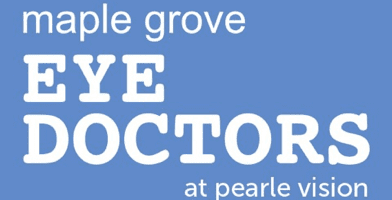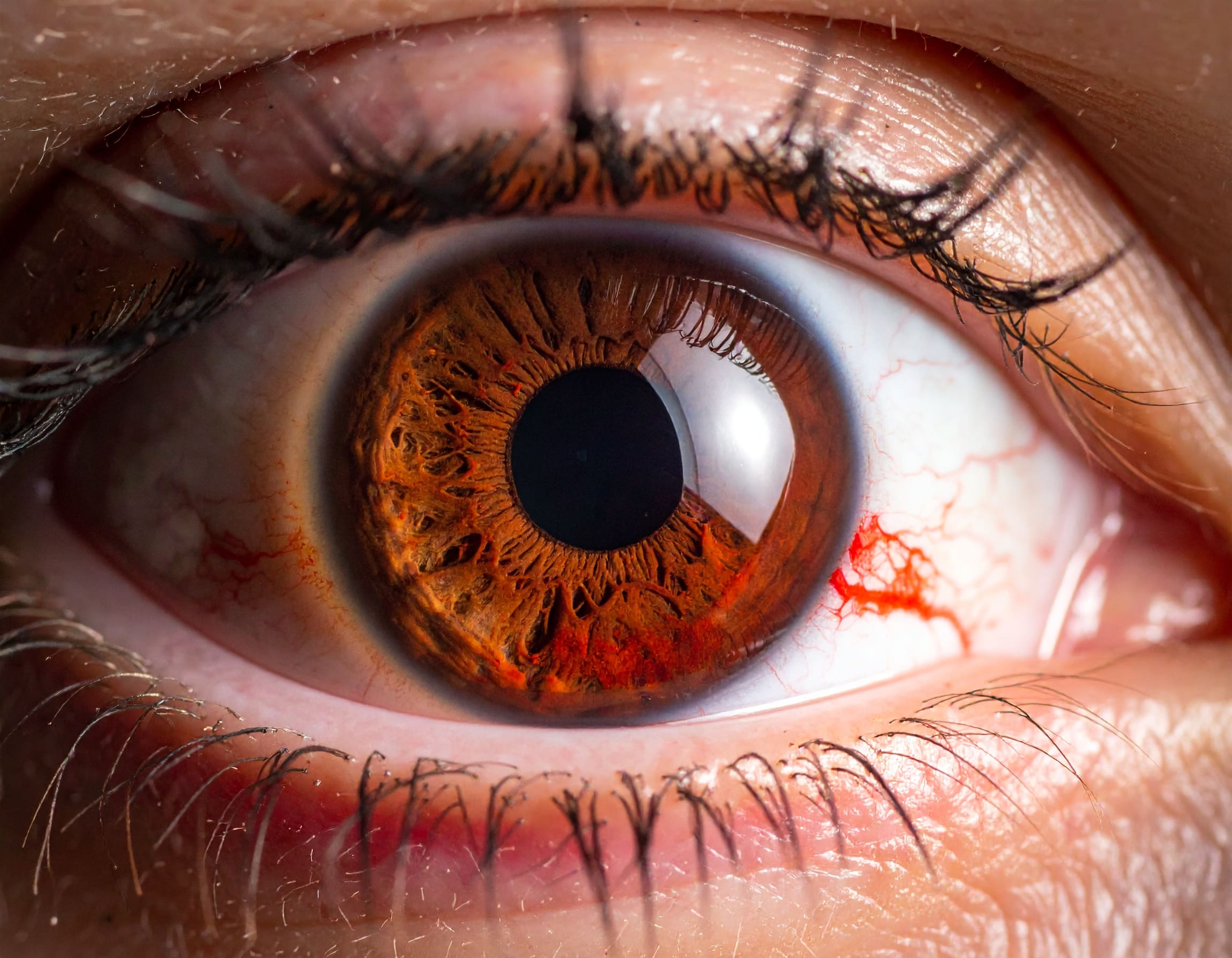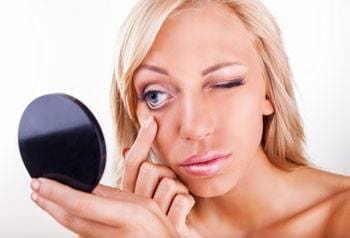Are you suddenly noticing a red splotch in the white area of your eye? Do not fret; you might be experiencing a Subconjunctival Hemorrhage, often abbreviated to SCH. A Subconjunctival hemorrhage is a common type of eye bleed that occurs when a blood vessel breaks in the eye, and the blood appears in the whites of the eyes. In most cases, it is harmless and goes away on its own. Let’s explore more details on what does a burst blood vessel in your eye means.
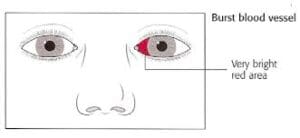
Causes of SCH
Doctors do not know what causes a burst blood vessel in the eye, but it can occur due to the use of contact lenses, an injury, or intense exercise or straining. The sclera has many minute blood vessels that can break and bleed easily. They are protected by the conjunctiva, which is a thin, transparent layer of tissue that covers the eye. When a blood vessel breaks, blood pools under the conjunctiva, meaning it is visible but trapped under this layer of tissue. Some people have an increased risk of SCH due to medication, health conditions, eye surgery, and more.
Usually, a burst blood vessel in the eye is harmless. In most cases, the mark on the eye will go away on its own with time as the blood naturally disperses. The eye may be red for a while, but this should begin to fade over the next 1-2 weeks. Occasionally, SCH can be a sign of an underlying condition. This is more likely if the bleeding is persistent or recurs often.
Understanding the Symptoms
The main symptom of SCH is a red patch appearing on the white of the eye.
At first, the patch may be an opaque red with clear borders before becoming faded and less distinct. The eye may develop a bruised or yellow appearance as the hemoglobin and other blood components break down.
Usually, SCH is painless and does not affect vision, although it may cause a swollen or scratchy feeling. It typically only affects the whites of the eyes, not the iris or pupil. Doctors categorize the potential causes of SCH into two groups: Traumatic and Spontaneous.
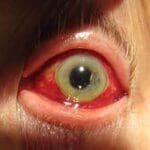
Traumatic Factors
In this context, the word “traumatic” refers to a physical trauma or injury that affects the eye, causing a small blood vessel to break. Foreign objects getting into the eye, a direct blow, or harsh rubbing of the eyes are some common examples leading to a burst vessel.
Another common cause of this type of injury is the use of contact lenses. As contact lenses have become more popular, the incidence of traumatic SCH has also increased.
This can occur accidentally when applying or removing the lens or due to issues with the lens itself, such as surface deposits or defects that may cause friction.
If people use disposable contact lenses for longer than the manufacturer advises, this may also contribute to SCH. This is because the materials in these lenses start to break down at the edges over time, causing rougher edges. DO. NOT. DO. THIS.
In addition, people who wear contact lenses can sometimes develop eye conditions that disrupt the flow of tears, causing inflammation or dryness.
Pro Tip: Always follow the manufacturer’s instructions for lens use.
Spontaneous Triggers
Conditions that lead to eye rubbing, such as dry eye syndrome, allergies, and blepharitis, can also be contributing factors. These conditions cause eye discomfort and then eye rubbing, which can be involuntary or during sleep and can cause the blood vessels to burst.
According to research, in almost half of all cases, doctors do not identify a cause of SCH. Experts call these cases spontaneous or idiopathic because they occur for no apparent reason or when blood pressure suddenly increases. This can happen when someone coughs, vomits, or takes part in strenuous exercise, such as lifting heavy weights. In most cases, our doctors would not recommend using ‘red eye remover’ drops. Read more about Red Eye Remover Drops.
Medical Factors
Some health conditions can also be responsible for a burst of blood vessels in the eye. Hypertension (high blood pressure) can cause this to happen even if a person is taking medication to manage the condition. Other vascular disorders, such as Diabetes and Hyperlipidemia, can also increase the risk. Blood disorders such as hemophilia or platelet illnesses can result in prolonged bleeding, even if there’s minor trauma. All these and many more health conditions can increase the likelihood of leading to subconjunctival hemorrhages.
Medications, including non-steroidal anti-inflammatory drugs and anticoagulants, such as warfarin or heparin, may also make burst blood vessels more likely. Heavy and long-term usage is strictly prohibited as the bleeding can be more pronounced and last longer than expected. If you are concerned about a broken blood vessel in your eye, Schedule an Eye Exam Today.
Eye Surgery
Eye surgeries, such as LASIK or cataract procedures, can sometimes lead to a Subconjunctival Hemorrhage (SCH). These treatments, while generally safe, involve manipulation and increased eye pressure. Inadvertently, they can cause the delicate blood vessels in the eyes to rupture and cause annoying symptoms. You must remain vigilant of any possible side effects and consult your ophthalmologist if you may be facing post-surgery concerns.
Precautions and Care
When it comes to preventing a burst blood vessel in the eye, several precautions can help. While you cannot prevent all instances of SCH, especially spontaneous ones, adopting a few essential precautions can reduce the chances or severity of a burst blood vessel in the eye.
- Wear protective glasses when engaged in activities that can risk the eyes, as well as when going outdoors.
- Minimize eye rubbing, especially if you’re suffering from allergies.
- Monitor your underlying health conditions, as they can increase the risk of SCH.
- Ensure reading or working in well-lit areas to reduce eye strain.
- Limit screen time and take frequent breaks to avoid straining the eyes.
- If your eyes are irritated, use a warm compress and do not rub the eyes, or you can spread the infection.
- Maintain good eye hygiene, particularly if you are prone to conditions like blepharitis.
- Increase your fluid intake to support vascular health.
- Include omega-3 fatty acids and vitamins C and E in your diet.
Maintaining eye health is not just about reacting to issues that arise but proactively taking care of your eyes all the time. Some eye conditions are also hereditary, so familiarizing yourself with your family’s eye health history can help you take better preventive measures.
Remember: Consult with an eye care professional if you have concerns about your eye health. Steer clear from self-diagnosis and OTC medications, as that can do more harm than good. Be up-to-date with your eye exams as well, which can help catch any serious problems early on.
When to Seek Medical Attention
As mentioned earlier, SCH is harmless and resolves on its own as the blood naturally disperses. However, it’s essential to seek the assistance of an expert healthcare professional if:
- The bleeding is persistent or recurrent
- You are experiencing discomfort, pain, or vision disturbances
- There are frequent occurrences of SCH
- You have an underlying medical condition
- You are taking medications that may affect blood vessel integrity
Take Action Now.
For many, the redness fades over 1-2 weeks. Generally, no specific treatment is needed as the eye heals on its own. However, persistent or recurring bleeding could mean you may be having an underlying health condition. If you are concerned about a burst blood vessel or overall eye health, do not leave it to chance. Schedule an eye exam with the Maple Grove Eye Doctors experts today. Your eye health is our top priority.
